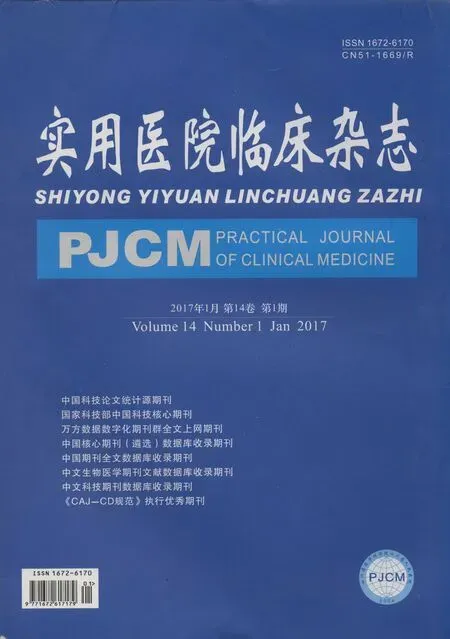心脏磁共振成像在冠心病中的应用进展
2017-04-02刘胜中综述郭应强审校
刘胜中 综述,郭应强 审校
(1.四川大学华西医院,四川 成都 610041;2.四川省医学科学院·四川省人民医院心脏外科中心,四川 成都 610072)
心脏磁共振成像在冠心病中的应用进展
刘胜中1,2综述,郭应强1审校
(1.四川大学华西医院,四川 成都 610041;2.四川省医学科学院·四川省人民医院心脏外科中心,四川 成都 610072)
心脏磁共振成像可一次性完成心脏结构与功能评估,且无电离辐射,被称为心脏“一站式”无创检查,越来越广泛地应用于临床。本文就冠状动脉磁共振成像、负荷心肌灌注首过磁共振成像、延迟增强磁共振成像在冠心病诊断和预后判断中的应用进展做一综述。
心脏磁共振;冠状动脉磁共振成像;负荷心肌灌注首过磁共振成像;延迟增强磁共振成像;冠心病;进展
心脏磁共振成像(cardiac magnetic resonance imaging,CMRI)可一次性完成心脏结构与功能(包括冠状动脉显影、血流灌注、室壁运动、存活心肌定量等)评估,且无电离辐射,被称为心脏“一站式”无创检查,越来越广泛地应用于临床[1]。随着我国人口的逐步老龄化,冠心病的发病率逐年升高,并成为威胁人类健康的主要疾病之一;其早期发现和及时治疗成为当前临床医生的首要任务和挑战[2]。本文就CMRI在冠心病中的应用进展做一综述。
1 冠状动脉磁共振成像(coronary magnetic resonance imaging,cMRI)
目前诊断冠心病的金标准仍然是冠状动脉造影(coronary angiography,CAG),但CAG是一种有创性检查,且禁忌证相对较多,无法观察管壁,不能有效检出易损斑块和血管正性重构[3]。而CMRI具有无创性、无电离辐射,且有良好的软组织对比度、多参数及任意层面成像等优势,逐渐被应用于临床冠状动脉成像[4]。
1.1 cMRI显示冠状动脉管腔 1987年Paulin等首次报道将磁共振用于主动脉根部和冠状动脉近段成像[5]。随后Manning等总结非对比增强cMRI对左主干和3主支近中段管腔总显示率达84%,因回旋支距体表线圈远、管径细,敏感度和特异度最低[6]。由于对比增强cMRI有更高的信噪比和对比噪声比,研究表明冠状动脉近中段显示率接近100%,远段显示率77.8%~94.4%[7]。另有研究证实全心成像或分段采集技术对主支管腔显示率无差异,但前者对分支显影更好、操作简单,易于显示变异血管。多中心研究显示,与管腔狭窄程度>50%的CAG做对照,cMRI诊断冠心病的平均准确性达72%(63%~81%),对除外左主干和3主支近段病变的阴性预测值接近100%[8]。刘新等报道与CAG对照,cMRI诊断管腔狭窄敏感性47.6%~83.3%,特异性71.4%~73.7%,评价严重钙化斑块引起的管腔狭窄cMRI较CT有明显优势[9]。Sakuma等采用1.5 T非对比增强的SSFP 脉冲序列诊断冠心病的敏感性、特异性及准确性分别为82%、90%及87%[10]。Yang等采用3T对比增强的FLASH脉冲序列诊断冠心病的敏感性、特异性及准确性分别为91%、83%及84%[11]。Ma等采用32通道线圈高并行采集加速3T冠状动脉MRA的研究结果表明,该方法可显著缩短扫描时间,图像质量好,提高对冠状动脉有意义狭窄的诊断准确性,并可清晰显示冠状静脉解剖[12]。冠状动脉旁路移植术(coronary artery bypass graft,CABG)术后静脉桥血管因管径大、运动幅度小而易被显示,已有经cMRI诊断桥血管狭窄或闭塞的个案报道,但对桥血管吻合口及固有血管评价仍受限;此外搭桥后遗留的胸骨钢丝和止血夹形成局部伪影和信号丢失,进一步限制cMRI的临床应用。支架术后的随访是cMRI的弱项,因支架金属伪影的干扰导致局部信号缺失,不能确切评价支架内再狭窄,仅通过显示支架前后的血管间接判断通畅程度。由于冠状动脉解剖关系重叠,传统造影技术即使采用多角度投射,仍难以显示异常起源血管的近段或是与心腔的毗邻关系,据统计CAG仅能诊断50%的起源异常。cMRI 能显示三维解剖结构、对近段血管显示率高,无创无辐射,可作为诊断冠状动脉先天变异的方法之一[13]。
1.2 cMRI显示冠状动脉管壁 2000年Fayad等首次提出黑血冠状动脉管壁MRI的概念,早期多限于动物模型及离体或在体人的颈动脉、主动脉等较大血管[14]。MRI因抑制血流和血管周围组织信号而直接显示管壁,管壁增厚通常是冠状动脉硬化的结果,对照研究显示冠心病患者的平均管壁厚度约(1.95±0.17)mm,而正常组MRI测量厚度约(1.7±0.19)mm。Malayeri等报道应用cMRI测量冠状动脉管壁厚度和截面积,可成为评价动脉硬化的无创性检查手段之一[15]。MRI对主动脉、颈动脉等大中血管的斑块研究已较为成熟;其利用斑块组织学成分如脂质、钙化、纤维组织的T1、T2值的不同,在T1 WI、T2WI及PD序列上呈现的信号差异分析斑块的组织学成分及比率,从而推测斑块的稳定性。因颈动脉管径较大,位置表浅易被探测,扫描结果与病理对照一致性好,现已初步用于临床。而冠状动脉解剖结构细小、走行迂曲及位置深埋,正常成人管腔内径<10 mm、管壁厚度0.5~2.0 mm,周围有心包脂肪包裹,内有流动的血液。所以cMRI面临的问题除心脏、呼吸运动伪影外,还需要有足够的空间分辨率和与周围组织的对比。相信随着硬件、线圈和序列的研发,经食道、血管内MRI研究的拓展,分子影像学研究的深入,cMRI将成为诊断冠状动脉疾病的重要无创性检查手段。
2 负荷心肌灌注首过磁共振成像(first-pass cardiac magnetic resonance perfusion,CMRP)
负荷CMRP是在图像采集同时静脉注入血管扩张剂(如腺苷、潘生丁、瑞加德松)造成心肌充血,当冠状动脉存在严重狭窄时,相应供血区域灌注量明显下降,表现为灌注图像信号降低[16]。CMRP比SPECT具有更高的时间及空间分辨率,其与金标准PET的诊断价值相仿,但无电离辐射[17,18]。CMRP诊断冠心病具有很高的准确性,Schwitter等应用EPI序列进行负荷心肌灌注成像,当以PET作为标准时其敏感性为91%,特异性为94%;当以CAG作为标准时其敏感性为87%,特异性为85%[19]。多中心随机对照试验结果提示,在CAG下冠状动脉狭窄≥50%的患者中,负荷CMRP的敏感度优于SPECT(0.67和0.59),特异度低于后者(0.61和0.72)[20]。荟萃分析提示负荷CMRP诊断冠心病(CAG下冠状动脉狭窄≥70%)的敏感度和特异度分别为0.91和0.80[21]。压力导丝(FFR)作为功能学诊断金标准,能从病理生理学角度与血管功能相对应,从而更准确地评估负荷CMRP的价值[22]。Lockie等对42例可疑冠心病患者的研究提示,3T负荷CMRP诊断冠心病(FFR<0.75)的敏感度和特异度分别为0.82和0.94[23]。Cheng等通过对3.0 T及1.5 T Turbo FLASH MR首过心肌灌注成像的比较证实3.0 T MR在诊断单支血管及多支血管病变方面优势显著,但3.0 T及1.5 T MR首过心肌灌注成像总的诊断准确性没有明显差别[24]。另一项荟萃分析表明,在平均32个月的随访中,负荷CMRP未见明显灌注受损的冠心病患者急性心肌梗死及心源性死亡的发生率较阳性患者明显降低(0.8%对4.9%),这对指导冠心病患者的治疗和判断预后具有重要作用[25]。负荷CMRP 亦可应用于CABG术后血流灌注评估并定位受损区域[26]。
3 延迟增强磁共振成像(delayed-enhancement magnetic resonance imaging,DE-MRI)
左室功能严重下降的冠心病患者在进行血运重建术时风险极大,所以准确评价心肌活性决定是否进行血运重建治疗对冠心病患者具有重要的临床指导意义[27]。DE-MRI凭借无辐射、良好的空间分辨率和任意层面成像,并可同时综合利用MRI心脏电影、心肌灌注等多种技术全面检测心肌活性等优点,在心脏结构和功能、心肌活性的评价方面具有明显优势。
DE-MRI可发现心肌的不可逆损伤,实现梗死及瘢痕组织的定性及定量分析,从而预测患者预后[28]。在静脉注射对比剂10~15 min后使用反转恢复序列,正常存活心肌呈无信号或黑色,不可逆梗死区域因对比剂潴留表现为信号增强或亮色;该序列可使不同性质心肌的信号强度增强50%~500%,使肉眼可分辨出梗死区域,目前常用的相位敏感反转恢复序列对反转时间矫正的依赖较少,减少对操作者的依赖,提高了可重复性[28]。DE-MRI还可以准确地反映出心肌梗死的范围及形状,甚至可检测到<1 g的心肌梗死[29],尤其对于心内膜下梗死的敏感度高于SPECT及PET[28,30]。DE-MRI还可用于诊断常规检查,如心电图、心脏超声等难以发现的右心室心肌梗死[31]。Kwong等对没有心肌梗死病史但怀疑冠心病的患者进行研究发现,DE-MRI检测出的心肌梗死疤痕是心脏病死亡事件强有力的预测指标[32]。DE-MRI对乳头肌梗死亦有较高的检测率,可指导是否进行瓣膜手术[33]。由于 DE-MRI可作为心肌不可逆性损失的证据,因而在临床上可以决定有没有必要采取干预措施来重建血供[34]。应用DE-MRI结合室壁运动情况,通过分析局部室壁心脏功能的改变来判断心肌缺血区,可以鉴别心肌活力;异常的室壁运动和特异性更高的室壁厚度变化异常是局部心肌功能降低的表现,这样可以在术前对患者进行筛选并能判定预后效果。DE-MRI和MRI的T2加权像(T2WI)相结合,还可以鉴别急慢性心肌梗死;这是因为从T2WI上可以观察到急性心肌梗死区的水肿,该区域不会出现延迟强化,但是它可以提示“危险区域”的存在[35]。Stork等指出,DE-MRI和T2WI可以可靠鉴别急慢性心肌梗死,因为水肿在急慢性心肌梗死鉴别上的敏感性、特异性分别为96%、98%[36]。结合磁共振心肌灌注成像可以了解心肌血供灌注情况,灌注缺失区提示微血管堵塞,而在DE-MRI上表现为无强化区,最典型的表现为心内膜下层面,该无强化区被周围强化心肌包绕;这一个微血管堵塞现象的存在常常与局限性心功能失调后心功能恢复不全、左室功能持续失调息息相关[37]。Regenfus等通过6年的随访研究发现,在ST段抬高型心肌梗死患者中,若出现微血管堵塞现象,MACE事件发生率更高[38]。
DE-MRI对心肌梗死患者预后评估起到重要作用。Eitel等对738例ST段抬高急性心肌梗死患者的1年随访结果表明,DE-MRI发现的乳头肌梗死提示患者有更大面积的梗死、较少的残余心肌、更严重的再灌注损伤以及更高的不良心脏事件发生率[39]。此外,DE-MRI发现的梗死范围与患者最终左室射血分数恢复呈负相关,即其梗死透壁程度可预测相应心肌收缩力恢复程度[29]。心肌梗死透壁程度超过50%的节段,心肌功能完全恢复的可能性很低[40]。杨滔等研究发现,瘢痕心肌节段≤4的冠心病患者,无论其左室的整体功能亦或几何形,CABG术后心功能均有显著改善,敏感性和特异性分别为95.5%和88.9%[41]。Boyé等研究表明,心肌梗死透壁程度与患者致死性心律失常和心源性死亡发生率呈正相关[42]。此外心肌梗死面积的大小亦是一项强有力的预测指标,Kelle等指出心肌梗死面积在预测心肌恢复能力上,比左室射血分数、小剂量多巴酚丁胺负荷试验等检查方法更有效[43]。
4 小结
综上,随着磁共振软、硬件技术的飞速发展,磁共振成像速度的不断提高,时间分辨力及空间分辨力的明显改善,CMRI已能准确提供心脏解剖、功能、心肌灌注、心肌活性、室壁运动、心脏代谢和冠状动脉显影等信息,并显现出超声心动图、SPECT及PET难以超越的优势,必将为冠心病的诊断、治疗及预后判断提供宝贵、丰富而全面的信息[44]。
[1] Karamitsos TD,Dall'Armellina E,Choudhury RP,et al.Ischemic heart disease:comprehensive evaluation by cardiovascular magnetic resonance[J].Am Heart J,2011,162(1):16-30.
[2] Saeed M,Van TA,Krug R,et al.Cardiac MR imaging:current status and future direction[J].Cardiovasc Diagn Ther,2015,5(4):290-310.
[3] Ward MR,Pasterkamp G,Yeung AC,et al.Arterial remodeling.Mechanisms and clinical implications[J].Circulation,2000,102(10):1186-1191.
[4] Ahmad IG,Abdulla RK,Klem I,et al.Comparison of stress cardiovascular magnetic resonance imaging(CMR) with stress nuclear perfusion for the diagnosis of coronary artery disease[J].J Nucl Cardiol,2015,15:242.
[5] Paulin S,Von Schulthess GK,Fossel E,et al.MR imaging of the aortic root and proximal coronary arteries[J].Am J Roentgenol,1987,148(4):665-670.
[6] Manning WJ,Li W,Edelman RR.A preliminary report comparing magnetic resonance coronary angiography with conventional angiography[J].N Engl J Med,1993,328(12):828-832.
[7] 李晓兵,史晓,秦明明,等.导航技术三维对比剂增强磁共振冠状动脉成像[J].中华放射学杂志,2005,39(12):1269-1272.
[8] Kim WY,Danias PG,Stuber M,et al.Coronary magnetic resonance angiography for the detection of coronary stenoses[J].N Engl J Med,2001,345(26):1863-1869.
[9] 刘新,赵锡海,程流泉,等.冠状动脉CT和MR血管成像诊断粥样硬化斑块和狭窄的对比研究[J].中华放射学杂志,2006,40(11):1156-1160.
[10]Sakuma H,Ichikawa Y,Chino S,et al.Detection of coronary artery stenosis with whole-heart coronary magnetic resonance angiography[J].J Am Coll Cardiol,2006,48(10):1946-1950.
[11]Yang Q,Li K,Liu X,et al.Contrast-enhanced whole-heart coronary magnetic resonance angiography at 3.0-T:a comparative study with X-ray angiography in a single center[J].J Am Coll Cardiol,2009,54(1):69-76.
[12]Ma H,Tang Q,Yang Q,et al.Contrast-enhanced whole-heart coronary MRA at 3.0 T for the evaluation of cardiac venous anatomy[J].Int J Cardiovasc Imaging,2011,27(7):1003-1009.
[13]Ripley DP,Saha A,Teis A,et al.The distribution and prognosis of anomalous coronary arteries identified by cardiovascular magnetic resonance:15 year experience from two tertiary centres[J].J Cardiovasc Magn Reson,2014,16:34.
[14]Fayad ZA,Fuster V,Fallon JT,et al.Noninvasive in vivo human coronary artery lumen and wall imaging using black-blood magnetic resonance imaging[J].Circulation,2000,102(5):506-510.
[15]Malayeri AA,Macedo R,Li D,et al.Coronary vessel wall evaluation by magnetic resonance imaging in the multi-ethnic study of atherosclerosis:determinants of image quality[J].J Comput Assist Tomogr,2009,33(1):1-7.
[16]Gerber BL,Raman SV,Nayak K,et al.Myocardial first-pass perfusion cardiovascular magnetic resonance:history,theory,and currentstate of the art[J].J Cardiovasc Magn Reson,2008,10:18.
[17]Kelle S,Chiribiri A,Vierecke J,et al.Long-term prognostic value of dobutamine stress CMR[J].JACC Cardiovasc Imaging,2011,4(2):161-172.
[18]Jaarsma C,Leiner T,Bekkers SC,et al.Diagnostic performance of noninvasive myocardial perfusion imaging using single-photon emission computed tomography,cardiac magnetic resonance,and positron emission tomography imaging for the detection of obstructive coronary artery disease a meta-analysis[J].J Am Coll Cardiol,2012,59(19):1719-1728.
[19]Schwitter J,Nanz D,Kneifel S,et al.Assessment of myocardial perfusion in coronary artery disease by magnetic resonance:a comparison with positron emission tomography and coronary angiography[J].Circulation,2001,103(18):2230-2235.
[20]Schwitter J,Wacker CM,Wilke N,et al.MR-IMPACT II:Magnetic Resonance Imaging for Myocardial Perfusion Assessment in Coronary artery disease Trial:perfusion-cardiac magnetic resonance vs.single-photon emission computed tomography for the detection of coronary artery disease:a comparative multicentre,multivendor trial[J].Eur Heart J,2013,34(10):775-781.
[21]de Jong MC,Genders TS,van Geuns RJ,et al.Diagnostic performance of stress myocardial perfusion imaging for coronary artery disease:a systematic review and meta-analysis[J].Eur Radiol,2012,22(9):1881-1895.
[22]Costa MA,Shoemaker S,Futamatsu H,et al.Quantitative magnetic resonance perfusion imaging detects anatomic and physiologic coronary artery disease as measured by coronary angiography and fractional flow reserve[J].J Am Coll Cardiol,2007,50(6):514-522.
[23]Lockie T,Ishida M,Perera D,et al.High-resolution magnetic resonance myocardial perfusion imaging at 3.0-Tesla to detect hemodynamically significant coronary stenoses as determined by fractional flow reserve[J].J Am Coll Cardiol,2011,57(1):70-75.
[24]Cheng AS,Pegg TJ,Karamitsos TD,et al.Cardiovascular magnetic resonance perfusion imaging at 3-tesla for the detection of coronary artery disease:a comparison with 1.5-tesla[J].J Am Coll Cardiol,2007,49(25):2440-2449.
[25]Lipinski MJ,McVey CM,Berger JS,et al.Prognostic value of stress cardiac magnetic resonance imaging in patients with known or suspected coronary artery disease a systematic review and meta-analysis[J].J Am Coll Cardiol,2013,62(9):826-838.
[26]Klein C,Nagel E,Gebker R,et al.Magnetic resonance adenosine perfusion imaging in patients after coronary artery bypass graft surgery[J].JACC Cardiovasc Imaging,2009,2(4):437-445.
[27]Yang T,Lu MJ,Sun HS,et al.Myocardial scar identified by magnetic resonance imaging can predict left ventricular functional improvement after coronary artery bypass grafting[J].PLoS One,2013,8(12):e81991.
[28]von Knobelsdorff-Brenkenhoff F,Schulz-Menger J.Cardiovascular magnetic resonance imaging in ischemic heart disease[J].J Magn Reson Imaging,2012,36(1):20-38.
[29]Schwitter J,Arai AE.Assessment of cardiac ischaemia and viability:role of cardiovascular magnetic resonance[J].Eur Heart J,2011,32(7):799-809.
[30]Wagner A,Mahrholdt H,Holly TA,et al.Contrast-enhanced MRI and routine single photon emission computed tomography(SPECT) perfusion imaging for detection of subendocardial myocardial infarcts:an imaging study[J].Lancet,2003,361(9355):374-379.
[31]Galea N,Francone M,Carbone I,et al.Utility of cardiac magnetic resonance(CMR) in the evaluation of right ventricular(RV) involvement in patients with myocardial infarction(MI)[J].Radiol Med,2014,119(5):309-317.
[32]Kwong RY,Sattar H,Wu H,et al.Incidence and prognostic implication of unrecognized myocardial scar characterized by cardiac magnetic resonance in diabetic patients without clinical evidence of myocardial infarction[J].Circulation,2008,118(10):1011-1020.
[33]Okayama S,Uemura S,Soeda T,et al.Clinical significance of papillary muscle late enhancement detected via cardiac magnetic resonance imaging in patients with single old myocardial infarction[J].Int J Cardiol,2011,146(1):73-79.
[34]Plass A,Goetti RP,Emmert MY,et al.The potential impact of functional imaging on decision making and outcome in patients undergoing surgical revascularization[J].Thorac Cardiovasc Surg,2015,63(4):270-276.
[35]Abdel-Aty H,Zagrosek A,Schulz-Menger J,et al.Delayed enhancement and T2-weighted cardiovascular magnetic resonance imaging differentiate acute from chronic myocardial infarction[J].Circulation,2004,109(20):2411-2416.
[36]Stork A,Muellerleile K,Bansmann PM,et al.Value of T2-weighted,first-pass and delayed enhancement,and cine CMR to differentiate between acute and chronic myocardial infarction[J].Eur Radiol,2007,17(3):610-617.
[37]Nagao M,Higashino H,Matsuoka H,et al.Clinical importance of microvascular obstruction on contrast-enhanced MRI in reperfused acute myocardial infarction[J].Circ J,2008,72(2):200-204.
[38]Regenfus M,Schlundt C,Krähner R,et al.Six-year prognostic value of microvascular obstruction after reperfused st-elevation myocardial infarction as assessed by contrast-enhanced cardiovascular magnetic resonance[J].Am J Cardiol,2015,116(7):1022-1027.
[39]Eitel I,Gehmlich D,Amer O,et al.Prognostic relevance of papillary muscle infarction in reperfused infarction as visualized by cardiovascular magnetic resonance[J].Circ Cardiovasc Imaging,2013,6(6):890-898.
[40]Kim RJ,Wu E,Rafael A,et al.The use of contrast-enhanced magnetic resonance imaging to identify reversible myocardial dysfunction[J].N Engl J Med,2000,343(20):1445-1453.
[41]杨滔,陆敏杰,孙寒松,等.延迟增强磁共振显像对冠状动脉旁路移植术后心功能改善的预测价值[J].中国循环杂志,2014,29(2):115-119.
[42]Boyé P,Abdel-Aty H,Zacharzowsky U,et al.Prediction of life-threatening arrhythmic events in patients with chronic myocardial infarction by contrast-enhanced CMR[J].JACC Cardiovasc Imaging,2011,4(8):871-879.
[43]Kelle S,Roes SD,Klein C,et al.Prognostic value of myocardial infarct size and contractile reserve using magnetic resonance imaging[J].J Am Coll Cardiol,2009,54(19):1770-1777.
[44]Yahagi K,Joner M,Virmani R.Should CMR Become the New Darling of Noninvasive Imaging for the Monitoring of Progression and Regression of Coronary Heart Disease[J].J Am Coll Cardiol,2015,66(3):257-260.
Application progress of cardiac magnetic resonance imaging in coronary heart disease
LIU Sheng-zhong,GUO Ying-qiang
R814.42;R541.4
B
1672-6170(2017)01-0141-04
2016-01-09;
2016-06-24)
